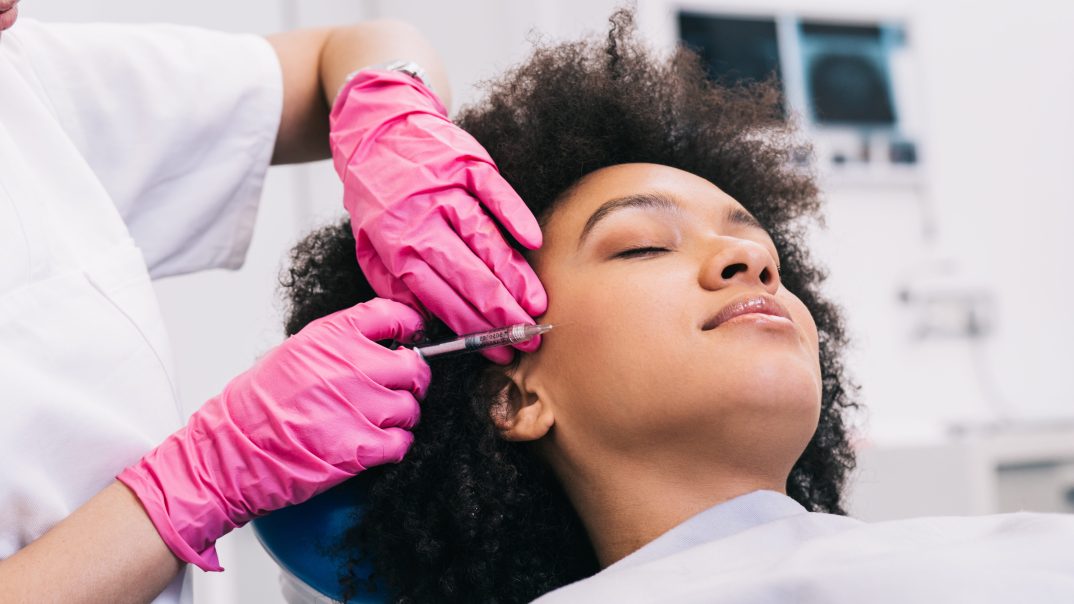Will Botox keep your edges laid? Everything you need to know about trending injectables
Black aesthetics expert Michelle German breaks down fillers, Botox, and the stigma of injectables.

Beauty standards are as ever-changing as the latest TikTok trends, and there’s currently a movement brewing, challenging beauty biases and raising an impeccably arched eyebrow at stereotypes. Lately, you may have noticed more and more folks you follow talking about Botox and fillers — so what’s all the buzz about?
Generally, when people think of cosmetic procedures, they think of rigid faces, overfilled lips, and an overall plastic-like appearance, all in a futile effort to freeze time. Since the turn of the millennium, the pursuit of eternal youth has taken a decidedly syringe-shaped turn — and in recent years, has become accessible to more than just the elite. However, before getting into injectables, there are things to be aware of, especially for those of us with melanated skin. TheGrio spoke with Michelle German, board-certified physician assistant and aesthetics director at Capital Aesthetic + Laser Center, to get an understanding of what Black people need to know before going under the needle.
The difference between Botox and fillers
Injectables 101: Botox relaxes muscles while fillers plump areas of the skin. When breaking down the effects of Botox on the skin, German compared it to a rest day at the gym.
“Think about your facial muscles [the same way] you think about the muscles on anyplace else on your body. If you go to the gym every single day and you do 100 curls, your biceps and your arms are going to be super strong, and the muscle is going to be really large because you work out every single day,” she explained. “The same thing goes for your facial muscles. Working out facial muscles is basically using facial expressions, [and over time] those muscles become stronger [while] the skin loses collagen and elastin. The combination of losing that collagen and elastin with the strength of the muscle can [create the appearance of] lines on the skin.”
By relaxing the muscles on your face through injectables, you’re essentially giving the muscles a break from the daily workouts they endure when you make facial expressions, thus explaining why Botox can often make facial movements seem limited. Ultimately, Botox can be used to prevent the appearance of fine lines.
Similarly, German compared the plumping effects of fillers to putting air in a flat tire. Although they are commonly used on lips to enhance their appearance, fillers can be used to make up for the inevitable loss of collagen and elastin that occurs with aging.
“There’s not many things that you can do to yourself over the counter that are going to stimulate the type of collagen that is going to plump you back up. So when you’re doing filler, you’re just sort of putting air in a flat tire,” German shared. “Like your face is the car, and you’ve been driving the same car; eventually, that tire is going to lose air, it’s going to lose volume, [in other words] collagen and elastin. But whenever we do a little bit of filler, then we plump up that area so that you know you can continue to ride and keep going …without riding on a flat tire.”
It’s not an exclusively “white thing“
Just because “Black don’t crack” doesn’t mean it can’t use a little boost. Whether because of socioeconomic disparities or the belief that we don’t genetically need it, there’s been a long-held belief that Black people don’t participate in these sorts of minor cosmetic procedures. However, German’s experience in aesthetics for the past 10 years proves that to be false.
“When I first started, my clientele was people of color, mainly women of color, but age 50 was like my average,” said German, saying the only shift she’s seen recently has been in age diversity. “Now, my clientele ranges from probably, you know, like maybe 25 to 50.”
Botox is just a brand
Just as Vaseline is a popular brand for petroleum jelly or Chapstick is a brand for lip balm, Botox (or Botox Cosmetics) is a brand. As one of the most popular distributors of the cosmetic injectable scientifically known as “Botulinum toxin type A,” Botox became the most common acronym. However, there are a number of trusted brands of the neurotoxin treatment known to smooth wrinkles, so when referring to this sort of treatment, German often says “Tox.”
Recommended Stories
Is Botox the secret to laid edges and clear skin?
Because of how Botox is injected into the skin, the treatment can help address sweat concerns and sometimes even acne. Those who suffer from excess sweating (hyperhidrosis) often use Botox as a temporary solution as it can calm down sweat glands for three to four months, according to German. Understanding the way Botox can attack sweat, many Black women have begun using the same treatment to maintain their edges.
“As of a few years ago, Black women are using [Botox] in their hairlines so that they are able to work out without sweating out their hair,” German told theGrio. “It’s a smaller amount, and it’s diluted differently, but you can use it, and the same principle applies to sweating right along the hairline as it does like your armpits, so it is pretty cool.”
Above all else, it’s a medical procedure
“Social media makes everything look so easy and instant,” said German. “But people should know that it is still a medical procedure, that things that we are injecting, whether it be Botox or another different type of filler, are basically like prescribed medications.”
Though individuals can’t actually be prescribed fillers, they should only be purchased and administered by medical providers. German stresses the importance of going to a provider who is either board-certified or has completed the proper training to become an injector. While the requirements vary from state to state, the national standard to be an injector is to be a registered nurse, nurse practitioner, physician assistant, or medical doctor.
“You want to make sure that people know exactly what they’re doing. [That they] know the body and signs to look for,” she added. “Although it is something cosmetic and elective, there are still risks that are involved in each procedure.”
Final takeaways
Whether you decide to use a syringe to fight wrinkles, plump your face or protect your edges, German encourages everyone to ignore the stigmas surrounding cosmetic procedures and do their own research.
“In the age of “Housewives” and reality TV, when you’re seeing women that look too plumped up and fake, you just sort of automatically associate that with what fillers and these sort of cosmetic procedures can do,” she said. “You can get something done and not look fake.”
For German, it’s important clients leave her feeling good and looking like a refreshed version of themselves. So, before venturing into the world of nonsurgical cosmetic treatments, she advises people to do research on not only the treatment but the facility they choose to go to. Prior to any injections, patients should go in for a consultation in which they should ask questions like:
- What should I expect?
- How do you handle complications?
- Will you be able to treat whatever possible complications arise in the office?
“It’s a fun procedure to get done, and you feel better about yourself when you get it done,” German added. “But you still want to make sure you’re making an informed decision before doing it.”

Haniyah Philogene is a multimedia storyteller and Lifestyle reporter covering all things culture. With a passion for digital media, she goes above and beyond to find new ways to tell and share stories.
Never miss a beat: Get our daily stories straight to your inbox with theGrio’s newsletter.








